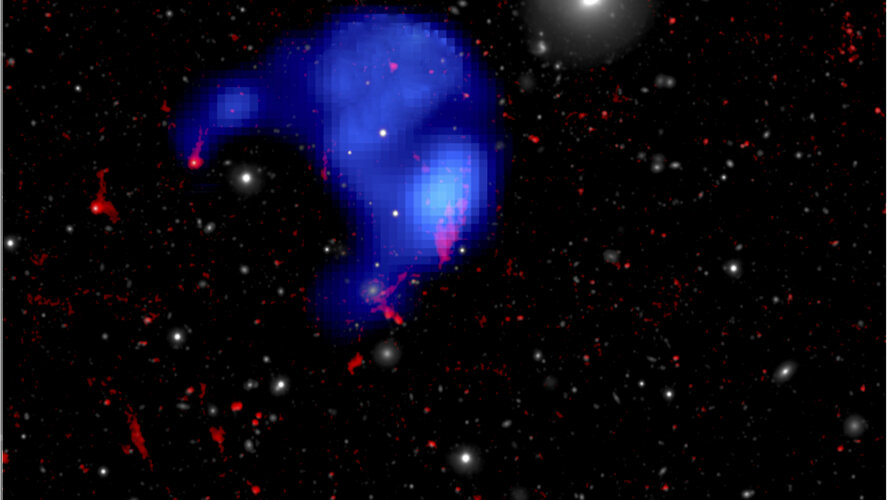
New observations made with ESA’s X-ray XMM Newton telescope have revealed an “orphan cloud” – an isolated cloud in a galaxy cluster that is the first discovery of its kind.
A lot goes on in a galaxy cluster. There can be anything from tens to thousands of galaxies bound together by gravity. The galaxies themselves have a range of different properties, but typically contain systems with stars and planets, along with the material in between the stars – the interstellar medium. In between the galaxies is more material – tenuous hot gas known as the intercluster medium. And sometimes in all the chaos, some of the interstellar medium can get ripped out of a galaxy and get stranded in an isolated region of the cluster, as this new study reveals.
Unexpected discovery
Abell 1367, also known as the Leo Cluster, is a young cluster that contains around 70 galaxies and is located around 300 million light-years from Earth. In 2017, a small warm gas cloud of unknown origin was discovered in A1367 by the Subaru telescope in Japan. A follow-up X-ray survey to study other aspects of A1367 unexpectedly discovered X-rays emanating from this cloud, revealing that the cloud is actually bigger than the Milky Way.
This is the first time an intercluster clump has been observed in both X-rays and the light that comes from the warm gas. Since the orphan cloud is isolated and not associated with any galaxy, it has likely been floating in the space between galaxies for a long time, making its mere survival surprising.
The discovery of this orphan cloud was made by Chong Ge at the University of Alabama in Huntsville, and colleagues, and the study has been published in Monthly Notices of the Royal Astronomical Society.
Along with data from XMM-Newton and Subaru, Chong and colleagues also used the Multi Unit Spectroscopic Explorer (MUSE) on the Very Large Telescope (VLT) to observe the cluster in visible light.
The orphan cloud is the blue umbrella-shaped part of the image. It has been colour-coded to show the X-ray part of the cloud in blue, the warm gas in red, and the visible region in white shows some of the galaxies in the cluster. The part of the cloud that had been discovered in 2017 (in red) overlaps with the X-ray at the bottom of the cloud.
How the cloud became an orphan
It was previously thought that the distribution of material between galaxies is smooth, however more recent X-ray studies have revealed the presence of clumps in clusters. It was theorised that clumps of gas in the clusters were originally the gas that exists between stars in individual galaxies. The intercluster gas acts as a wind that is strong enough to pull the interstellar gas out of the galaxy as the galaxy is moving through the cluster. However, observations showing that intercluster clumps are originally stripped interstellar material have never been made until now. The observation of the warm gas in the clump provides the evidence to show that this orphan cloud originated within a galaxy. Interstellar material is much cooler than intercluster material, and the temperature of the orphan cloud matches that of interstellar gas. The researchers were also able to determine why the orphan cloud has survived for as long as it has. An isolated cloud would be expected to be ripped apart by instabilities caused by velocity and density differences. However, they found that a magnetic field in the cloud would be able to suppress these instabilities.
Searching for the parent galaxy
It is likely that the parent galaxy of the orphan cloud is a massive one as the mass of the X-ray gas in the orphan is substantial. It is possible that the parent might one day be discovered with future observations by following some breadcrumbs. For example, there are traces of the warm gas that extend beyond the orphan cloud that could be used to identify the parent with more data. There are other unsolved mysteries regarding the cloud that could be deciphered with more observations, such as mysterious offset between the brightest X-rays and the brightest light from the warm gas.
A closer inspection of this orphan will also further our understanding of the evolution of stripped interstellar medium at such a great distance from its parent galaxy and will provide a rare laboratory to study other things such as turbulence and heat conduction. This study paves the way for research on intercluster clumps, as future warm gas surveys can now be targeted to search for other orphan clouds.
Click here for original story, Orphan cloud discovered in galaxy cluster
Source: ESA Top Multimedia